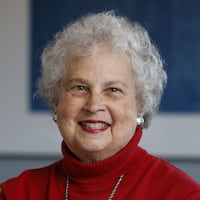HOW TO GO:
What: “Grandma Moses: An American Primitive,” a two-person drama starring Christine Decker that chronicles the life of America’s best-known folk artist. It follows Moses as a child, a young woman, a middle-aged widow, and a 100-year-old international celebrity.
Where: Dayton Art Institute’s Renaissance Auditorium
When: Dec. 3-6. The play will be presented at 8 p.m. on Thursday and Friday and 2 p.m. on Saturday and Sunday.
Tickets: $30 for adults, $26 for seniors. Tickets may be purchased online at daytonartinstitute.org, by calling 937-223-4ART (4278) or at the museum’s Guest Services Desk during regular hours.
ALSO: The DAI’s Leo Bistro will be open for dinner on Thursday, Dec. 3, offering a special menu for the show. Seating is limited, and advance reservations are required: call (937) 512-0146 for reservations.
You may remember that in 1989 actress Cloris Leachman toured the nation in a play based on the life of renowned artist, Anna Mary Robertson. The two-person drama, “Grandma Moses: An American Primitive,” was written by Stephen Pouliot, best known as the writer/producer of television award shows.
Because the Bennington Museum is home to the largest public collection in the world of paintings by the famous artist, it’s no surprise that the historic town’s Oldcastle Theatre Company decided to stage the show two years ago.
Actor Christine Decker, who played Grandma Moses in Bennington, will come to Dayton next month to reprise the role at the Dayton Art Institute. “It’s an entertaining piece of theater that’s beautifully written,” Decker said in a phone interview. “What’s exciting is to see a person who has remained so vital at that age. She painted thousands of paintings. It is really inspirational.”
Decker said the play is really about relationships, particularly the relationship the artist had with Otto Kallir, the owner of the New York gallery who first exhibited her work. “They were from such opposite worlds but their contentious relationship grew to be a friendship,” she said.
Joining her on stage to play Kallir and other male parts is actor Peter Langstaff. “His grandmother knew Grandma Moses,” Decker said.”He met her when he was very young and described her as the wrinkliest person he’d ever seen.”
Becoming Grandma Moses
Decker said she found it easy to identify with her character.
“This is the area in which she spent a lot of time,” said Decker. ” I was born about a half-hour away in Cambridge, New York. Grandma Moses lived in Eagle Bridge which is where my grandparents lived. My grandfather was a dairy farmer and the whole family knew her.”
A favorite family story involved Decker’s mother. “My grandmother asked my mother to visit Grandma Moses because my mother was an art student and Grandma Moses was becoming so well known,” she said. “My mother was from another world, influenced by mid-century modern art, so the idea of primitive painting didn’t interest her.”
But Decker’s mother agreed to pay a visit. “My mother was impressed with her personality. She said she was very frank,” relates Decker. “She showed her how she painted one color at a time. She would set up five or six paintings at a time, and do all the whites and all the browns, because she thought it saved paint. She was very thrifty.”
Decker said Grandma Moses was quite independent for a woman of her time. “Sometimes she took advice from others; sometimes she didn’t,” she said. “She did some things very traditionally, but in other ways she did not. She was very pragmatic, feisty, and had a good sense of humor.”
Anna Mary Robertson married a man she didn’t know. “She was a hired girl at a family’s house which was very typical of the region,” explained Decker. ” When a girl became 12, she would help around the house — building the stove fires, cooking and cleaning, and she would almost be like an indentured servant.”
Robertson became a hired girl at 12 and in her late 20s worked in a household with a hired man who proposed to her and suggested they move to Virginia. She agreed. “That’s pretty brave,” said Decker. “They had 10 children but only five survived.”
On the artwork
Decker said the character she portrays started out making yarn paintings. “All girls did needlework but she did it in a more artistic way. She did scenes, a scene of the Eagle Bridge for example. She sewed it,” Decker said.
When she could no longer hold a needle due to arthritis, Grandma Moses discovered she could hold a paint brush. “She would paint on Masonite,” Decker said. “I don’t think she was familiar with canvas. The world of art was very new to her and in those days, it wasn’t really encouraged.”
Grandma Moses thought fame was overblown. “She didn’t really get it, she didn’t think she had the skill to be famous,” Decker said. “She would roll her eyes and say: ‘I can’t believe they are getting $50 for this painting, I wouldn’t have paid more than $5 for it.’ She said that to my mother and everyone who met her said she was the same way. But I’m sure she was grateful for the money when it started coming in.
As for how much Grandma Moses paintings have increased in value, Decker said she has a friend who was able to start a theater company by selling some of the Grandma Moses paintings he had inherited from his family.
“I love to see women who do extraordinary things in a humble way, which exemplifies her,” concludes Decker. “I love that she did not allow fame to change her.”
About the Author

